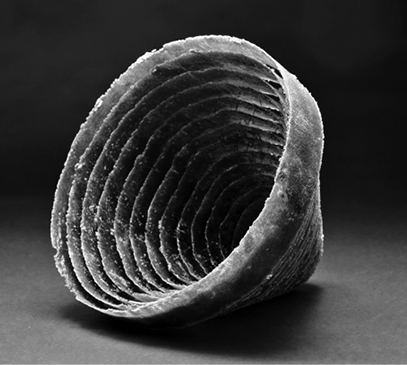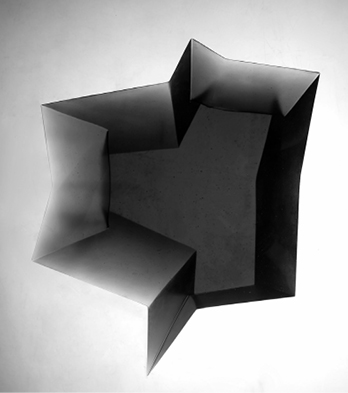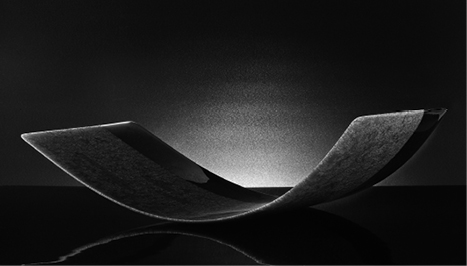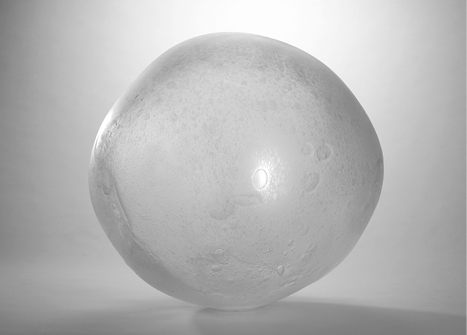Discussion
講評会
Comments on the Special Prizes

Loophole
近岡 令 CHIKAOKA, Rei
(JAPAN)

Water Well
ZHENG, Yi Han
(CHINA)

海碧絣–水面と光–
Surface and Light
上野 ツカサ UENO, Tsukasa
(JAPAN)

空形–ウツカタ–
横山 翔平 YOKOYAMA, Shohei
(JAPAN)
Takeda ───── Following the selection of prize winners, each jury member selected his/her own special prize winner.
I would like Professor Carlson to explain the winner of the William Douglas Carlson Prize, titled “Loophole” by CHIKAOKA Rei (Japan).
Carlson ─────Carlson: With the last piece I talked about low energy in a power. This piece has an entirely different kind of power.
Its power is just a simple fragility of glass. Simple cast and centric rings are held together just with the minimal amount of wire. At one point, we are seeing the mass of the piece from an angle and as we are more straight forward to the
piece, we are looking through it. And through it, there are not space beyond. That is ephemeral use of glass.
For me this piece actually makes me hold on my breath because it is that fragile and I can imagine being a maker of such a piece and hardly gone through all the processes to make the piece that has just almost like a skin of glass.
So shallow, so finite and so fragile as a petal. But I hold my breath and try not to damage the piece.
This award from each juror gives us a real chance to look again at the pieces. We have given some pieces awards, but there are many that need recognition. So the juror has a special opportunity to revisit a piece and see things that are really the energy of an exhibition like this.
Takeda ─────Professor Laursen, please talk about the winner of the Bodil Busk Laursen Prize, “Water Well” by ZHENG Yi Han (China).
Laursen ─────The artist from China is but living in Kanazawa now. The way to interpret and to transform them into other materials has always fascinated me. That is why I have chosen this work for my very special prize.
The artist has succeeded in creating the feeling of being in a city surrounded by high blocks and looking for the sky high above. Instead of looking up, the artist wants us to find the sky in the reflections of the sky in a well deep down among the buildings of the city. That is why the title of the work is “Water Well.”
The sculpture is as precise in its form as in its narrative. I am impressed and moved by its qualities, the characterization of the townscape into a very small scale, the perfection and beauty of its execution, and, as I mentioned already, the way the narrative evokes feelings and puts questions about our physical surroundings and our lives and dreams.
I have to see more woks by this artist in the years to come. And I want to thank this opportunity to give the special prize of my own choice.
Takeda ───── I will tell you the sizes of “Loophole” and “Water Well.” The former is 10cm in height and 47cm in length.
The latter is 28cm from the top to the bottom. Now, I would like Professor Yokoyama to talk about the winner of the Naoto Yokoyama Prize, “Surface and Light” by UENO Tsukasa(Japan). The size of the work is 63cm in length.
Yokoyama ─────The work is a piece of simple curved board of glass. It is less assertive. Its form is so simple that we might overlook the work. However, if you look at this work carefully,the precise woven patterns are truly beautiful. While looking at this work, I hit on an idea and stood it as if a wide scope screen. Then suddenly this work showed me another beauty which is quite different from that of the work displayed flat. Such a way of displaying the work might be different from the artist’s intention, but the work inspired my aesthetic sense and I felt a presentiment of new dimensions of this work. I decided to give my special prize to this work.
Takeda ───── Lastly, I would like to make some comments on the winner of the Atsushi Takeda Prize, “The Shape of the Sky - UTSUKATA –” by YOKOYAMA Shohei (Japan). It is a distorted sphere with 57cm in diameter. The artist’s concept on the fact sheet is too poetic to understand. I felt that the work evokes memories of the past.
It seems that the artist sticks to the idea of sealing such memories in the sphere of blown glass rather than expressing the memories as the form. I didn’t feel anything excellent in design and it has no self-assertion, but there is something strange about this work. Among art works including glass art, paintings and sculptures, some have clear selfassertion,but others do not for some reasons.
Honestly I dared to select this work as my prize winner because I expected the artist’s unknown future and I was a little charmed with the fact that this simple glass sphere anyway exists. As Professor Laursen mentioned before, I would like to look forward to the artist’s future.

